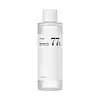What's inside
What's inside
 Key Ingredients
Key Ingredients

No key ingredients
 Benefits
Benefits

 Ingredients Side-by-side
Ingredients Side-by-side

Houttuynia Cordata Extract 77%
Skin ConditioningWater
Skin Conditioning1,2-Hexanediol
Skin ConditioningGlycerin
HumectantBetaine
HumectantPanthenol
Skin ConditioningSaccharum Officinarum Extract
MoisturisingPortulaca Oleracea Extract
Skin ConditioningButylene Glycol
HumectantVitex Agnus-Castus Extract
AstringentChamomilla Recutita Flower Extract
MaskingArctium Lappa Root Extract
Skin ConditioningPhellinus Linteus Extract
Skin ConditioningVitis Vinifera Fruit Extract
Skin ConditioningPyrus Malus Fruit Extract
Skin ConditioningCentella Asiatica Extract
CleansingIsopentyldiol
HumectantMethylpropanediol
SolventAcrylates/C10-30 Alkyl Acrylate Crosspolymer
Emulsion StabilisingTromethamine
BufferingDisodium EDTA
Houttuynia Cordata Extract 77%, Water, 1,2-Hexanediol, Glycerin, Betaine, Panthenol, Saccharum Officinarum Extract, Portulaca Oleracea Extract, Butylene Glycol, Vitex Agnus-Castus Extract, Chamomilla Recutita Flower Extract, Arctium Lappa Root Extract, Phellinus Linteus Extract, Vitis Vinifera Fruit Extract, Pyrus Malus Fruit Extract, Centella Asiatica Extract, Isopentyldiol, Methylpropanediol, Acrylates/C10-30 Alkyl Acrylate Crosspolymer, Tromethamine, Disodium EDTA
Water
Skin ConditioningPinus Densiflora Leaf Extract
AntimicrobialPropanediol
SolventGlycerin
HumectantHouttuynia Cordata Extract
Skin Conditioning1,2-Hexanediol
Skin ConditioningButylene Glycol
HumectantHyaluronic Acid
HumectantHydrolyzed Hyaluronic Acid
HumectantSodium Hyaluronate
HumectantGlycoproteins
Skin ConditioningEthylhexylglycerin
Skin ConditioningMorus Alba Leaf Extract
Skin ConditioningMorus Alba Flower Extract
Asiaticoside
AntioxidantAsiatic Acid
Skin ConditioningMadecassoside
AntioxidantMadecassic Acid
Skin ConditioningGluconolactone
Skin ConditioningCapryloyl Salicylic Acid
ExfoliatingSodium Citrate
BufferingHydroxyacetophenone
AntioxidantDisodium EDTA
Citric Acid
BufferingWater, Pinus Densiflora Leaf Extract, Propanediol, Glycerin, Houttuynia Cordata Extract, 1,2-Hexanediol, Butylene Glycol, Hyaluronic Acid, Hydrolyzed Hyaluronic Acid, Sodium Hyaluronate, Glycoproteins, Ethylhexylglycerin, Morus Alba Leaf Extract, Morus Alba Flower Extract, Asiaticoside, Asiatic Acid, Madecassoside, Madecassic Acid, Gluconolactone, Capryloyl Salicylic Acid, Sodium Citrate, Hydroxyacetophenone, Disodium EDTA, Citric Acid
 Reviews
Reviews

Ingredients Explained
These ingredients are found in both products.
Ingredients higher up in an ingredient list are typically present in a larger amount.
1,2-Hexanediol is a synthetic liquid and another multi-functional powerhouse.
It is a:
- Humectant, drawing moisture into the skin
- Emollient, helping to soften skin
- Solvent, dispersing and stabilizing formulas
- Preservative booster, enhancing the antimicrobial activity of other preservatives
Butylene Glycol (or BG) is used within cosmetic products for a few different reasons:
Overall, Butylene Glycol is a safe and well-rounded ingredient that works well with other ingredients.
Though this ingredient works well with most skin types, some people with sensitive skin may experience a reaction such as allergic rashes, closed comedones, or itchiness.
Learn more about Butylene GlycolDisodium EDTA plays a role in making products more stable by aiding other preservatives.
It is a chelating agent, meaning it neutralizes metal ions that may be found in a product.
Disodium EDTA is a salt of edetic acid and is found to be safe in cosmetic ingredients.
Learn more about Disodium EDTAGlycerin is already naturally found in your skin. It helps moisturize and protect your skin.
A study from 2016 found glycerin to be more effective as a humectant than AHAs and hyaluronic acid.
As a humectant, it helps the skin stay hydrated by pulling moisture to your skin. The low molecular weight of glycerin allows it to pull moisture into the deeper layers of your skin.
Hydrated skin improves your skin barrier; Your skin barrier helps protect against irritants and bacteria.
Glycerin has also been found to have antimicrobial and antiviral properties. Due to these properties, glycerin is often used in wound and burn treatments.
In cosmetics, glycerin is usually derived from plants such as soybean or palm. However, it can also be sourced from animals, such as tallow or animal fat.
This ingredient is organic, colorless, odorless, and non-toxic.
Glycerin is the name for this ingredient in American English. British English uses Glycerol/Glycerine.
Learn more about GlycerinHouttuynia Cordata Extract is more commonly known as Heart Leaf, Fish Mint, or Chameleon plant.
The components found in Heart Leaf give it antioxidant, hydrating, antimicrobial, and anti-inflammatory properties.
Heart Leaf is rich in flavonoids such as quercetin, apigenin, and more. It also contains polysaccharides, the most common type of carbs in food.
Flavonoids have been shown to be effective antioxidants. They help neutralize free-radical molecules. Free-radical molecules are unstable molecules that may damage our skin cells and DNA. The flavonoids in Heart Leaf also help soothe the skin.
Polysaccharides are naturally found in our skin. They play a role in hydrating and repairing the top layer of skin. The polysaccharides in Heart Leaf help moisturize our skin.
Studies show decanoyl acetaldehyde, a component of Heart Leaf oil, is effective at killing bacteria.
The name 'Fish Mint' comes from the herb's natural fishy smell. Is is native to southeast Asia and used throughout the continent for traditional cooking and medicine.
Learn more about Houttuynia Cordata ExtractWater. It's the most common cosmetic ingredient of all. You'll usually see it at the top of ingredient lists, meaning that it makes up the largest part of the product.
So why is it so popular? Water most often acts as a solvent - this means that it helps dissolve other ingredients into the formulation.
You'll also recognize water as that liquid we all need to stay alive. If you see this, drink a glass of water. Stay hydrated!
Learn more about Water